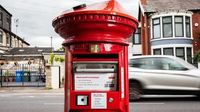Royal Mail’s iconic red postboxes, a fixture on Britain’s streets for nearly two centuries, are getting their most significant makeover yet. On August 27, 2025, Royal Mail announced the rollout of 3,500 solar-powered “postboxes of the future” across the UK, following a successful pilot earlier this year in Hertfordshire and Cambridgeshire. The move marks the largest redesign in the 175-year history of the postbox and is part of the company’s effort to adapt to a rapidly changing postal landscape, where online shopping and fierce competition from rivals like Amazon, Evri, and Yodel are reshaping how Britons send and receive parcels.
The new postboxes, set to appear in cities including Edinburgh, Manchester, Nottingham, Sheffield, and Sunderland, feature a digitally activated drop-down drawer powered by a solar panel discreetly placed on the top. This innovation enables customers to send and return labelled parcels up to the size of a shoebox—something that was never possible through traditional postboxes. A barcode scanner, also powered by solar energy, unlocks the drawer for parcels that are too large for the classic slot. For those still sending letters, a separate slot remains, ensuring the new design doesn’t abandon its original purpose.
According to BBC News, Royal Mail’s decision to orient the solar panels due south ensures optimal sunlight, a clever adaptation given the UK’s often unpredictable weather. Two design prototypes were tested during the pilot phase, including one with a black lid. Ultimately, the company opted to retain the classic red top, keeping with the familiar brand image that’s become synonymous with British life.
Customers can now use the Royal Mail app to scan the barcode, open the parcel drawer, and request proof of posting or track their parcels. This seamless digital integration is aimed squarely at those who shop or sell online, especially as second-hand marketplaces continue to boom. Jack Clarkson, Royal Mail’s Managing Director of Out of Home and Commercial Excellence, summed up the shift: “We are all sending and returning more parcels than ever before. This trend will only continue as online shopping shows no signs of slowing, particularly with the boom of second-hand marketplaces.”
Clarkson added, “There are 115,000 postboxes in the UK located within half a mile of 98% of addresses, making them by far the most convenient network of parcel drop-off points in the UK. Our message is clear, if you have a Royal Mail label on your parcel, and it fits, put it in a postbox and we’ll do the rest.” (Daily Mail)
Royal Mail’s push for convenience doesn’t stop at the postbox. The company boasts more than 23,500 parcel points nationwide, including 2,000 lockers, 7,500 Collect+ stores, 11,500 Post Office branches, 1,200 Royal Mail Customer Service Points, and 1,400 existing parcel postboxes. This vast network is designed to make sending, collecting, and returning parcels as easy as possible for customers—whether they’re busy professionals, students, or anyone in between.
The timing of this innovation is no accident. Royal Mail faces mounting challenges from tech-savvy competitors. Amazon, for instance, recently launched a delivery service on foot in central London, with associates wheeling carts of packages through the city’s streets. The pilot, taking place in Hackney, Westminster, and Islington, is part of Amazon’s broader mission to cut delivery emissions and achieve carbon neutrality by 2040. The company is also expanding its electric vehicle fleet and using electric rail services for the first time. As Daily Mail reported, this means Royal Mail no longer has the exclusive claim to postmen visiting UK homes, intensifying the battle for customer loyalty.
Royal Mail’s challenges are not limited to competition. The company, which was acquired by Czech billionaire Daniel Kretinsky’s EP Group for £3.6 billion earlier this year, has struggled to meet regulatory delivery targets. Ofcom, the UK’s postal regulator, requires that 90% of first-class post be delivered the next working day and 98.5% of second-class post within three days. However, figures released between March and June showed only 75.9% of first-class and 89.3% of second-class letters met these standards. The takeover by Kretinsky marked the first time the postal service, which traces its lineage back to Henry VIII, fell under foreign ownership—a move that sparked debate in Westminster and among the public.
In response to declining letter volumes and rising costs, Royal Mail recently received approval to scrap Saturday deliveries for second-class letters starting July 28, 2025. The company will now deliver second-class mail every other weekday, a change that Ofcom estimates could save Royal Mail between £250 million and £425 million annually. Despite the cutbacks, the regulator pledged to maintain the target for second-class post to arrive within three working days. Ofcom also launched a review of stamp prices due to concerns over affordability, reflecting the shifting habits of British consumers—less than a third of letters are sent now compared to twenty years ago, with forecasts suggesting this could drop to a fifth in the coming years.
Royal Mail’s solar-powered postboxes are seen as a bold attempt to modernize and maintain relevance in an evolving market. The company is betting that convenience, green technology, and digital integration will help it compete with private delivery giants and meet the changing needs of customers. As Post & Parcel highlighted, “Royal Mail is on a drive to make sending and receiving parcels as convenient as possible for customers and is rapidly expanding its number of parcel points.”
Yet, the question remains: will this technological leap be enough to counter the pressure from rivals who often offer cheaper delivery options and greater flexibility? While Royal Mail’s network of postboxes and parcel points is unrivaled in terms of reach—98% of UK addresses are within half a mile of a postbox—competitors continue to innovate, sometimes at a faster pace. The company’s efforts to keep pace with the digital economy and environmental demands are crucial, but the outcome is far from certain.
As the rollout of these postboxes continues over the coming months, Britons will soon see whether the “postbox of the future” can deliver not just parcels, but renewed confidence in one of the country’s oldest institutions.





